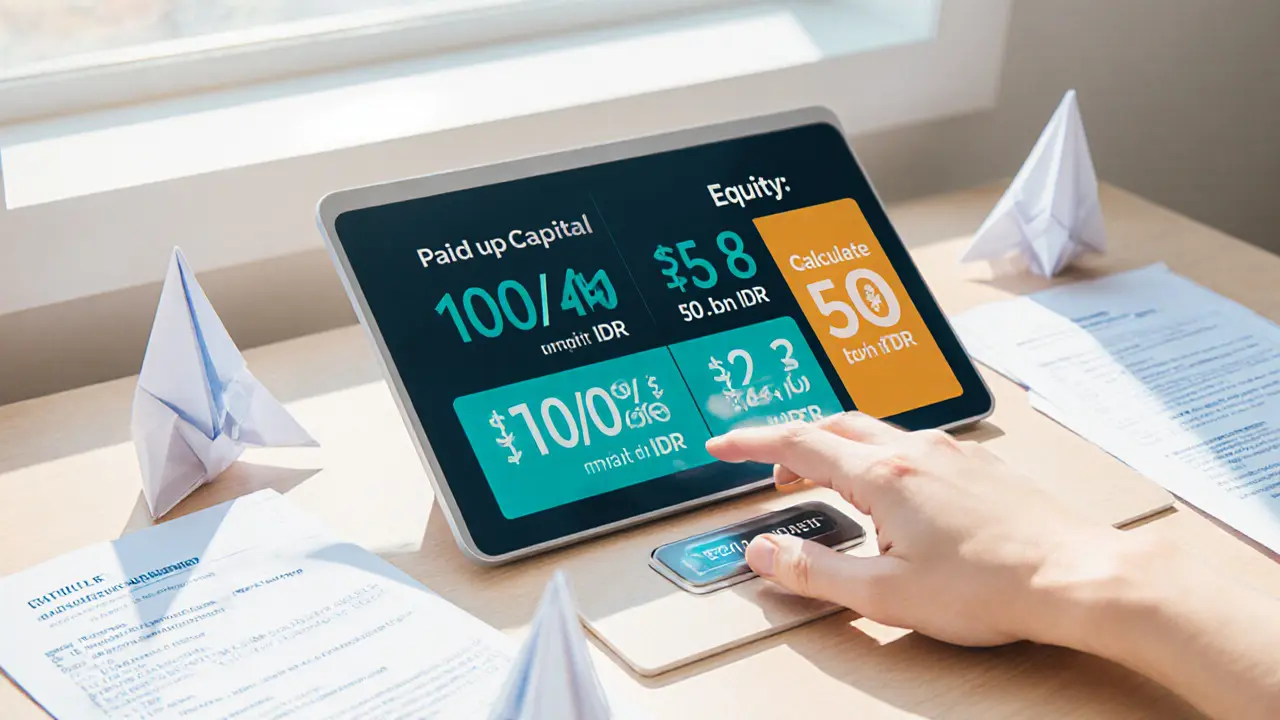Indonesia Crypto Exchange Licensing Calculator
Capital Requirements Calculator
Estimate the minimum capital needed to apply for a crypto exchange license in Indonesia under the new OJK DFA framework.
Estimated Requirements
Based on current regulations:
- Minimum Paid-up Capital: 100 billion IDR (~US$6 million)
- Minimum Equity: 50 billion IDR (~US$3 million)
Additional Requirements:
- Fully audited financial statements
- Legal entity registration in Indonesia
- Documentation in Indonesian with notarization
- Security schema with cryptographic protocols
- AML/KYC compliance program
Licensing Steps Overview
- Company Registration: Register legal entity via Ministry of Investments
- Document Collection: Articles of association, capital proof, technical schema
- Application Submission: Upload to OJK portal (translated & notarized)
- Regulatory Inspection: Security audit, AML/KYC check
- License Issuance: Valid for 3 years with quarterly reporting
When the Indonesian Crypto Exchange Licensing Requirements were overhauled in early 2025, the whole industry felt the shift. The new rules aim to protect investors, tighten security, and position Indonesia as a Southeast Asian crypto hub. If you’re planning to launch or relocate a trading platform, you need to know what the regulator expects, how much capital you must lock in, and which compliance hoops you’ll jump through.
TL;DR
- OJK now governs crypto under POJK 27/2024 (the DFA framework).
- Minimum paid‑up capital: 100billion IDR (≈US$6M); minimum equity: 50billion IDR (≈US$3M).
- Five‑step licensing: register company, gather docs, submit app, inspection, license issuance.
- All assets listed by the DFA Exchange; quarterly review keeps the list fresh.
- AML/KYC mandatory; report to PPATK; tax on trades is 0.21% with no VAT.
Overview of the New Regulatory Landscape
On 10January2025, the Otoritas Jasa Keuangan OJK took over crypto supervision from BAPPEBTI, introducing the Digital Financial Assets (DFA) framework under POJK 27/2024. This move re‑classified trading platforms as Digital Financial Asset Trading Providers, while the term “exchange” is now reserved for entities that manage the overall ecosystem.
The shift signals Indonesia’s ambition to become a regional crypto hub, but it also raises the bar for capital, governance, and technical safeguards.
Licensing Framework & Capital Requirements
Even though the capital thresholds stay the same as the old BAPPEBTI rules, the context is stricter. You must demonstrate:
- Paid‑up capital of at least 100billion rupiah (≈US$6million).
- Equity of at least 50billion rupiah (≈US$3million).
- Fully audited financial statements showing the capital is locked and not borrowed.
These figures act as a barrier to entry, ensuring only well‑funded operators can offer services. Smaller fintech startups often look for joint‑venture partners to meet the requirement.
Step‑by‑Step Licensing Process
The OJK licensing journey breaks down into five critical steps. Follow them closely to avoid costly delays.
- Company Registration: Register a legal entity in Indonesia via the Ministry of Investments online portal. Most foreign investors opt for a PT PMA (foreign‑owned PT).
- Document Collection: Gather the full set - articles of association, beneficial‑owner list, governance charter, proof of capital, and a detailed technical security schema.
- Application Submission: Upload the dossier to OJK’s licensing portal. All documents must be translated into Indonesian and notarized.
- Regulatory Inspection: OJK inspectors audit your security architecture, AML/KYC processes, and capital verification. Expect on‑site visits.
- License Issuance: After a successful inspection, OJK issues a DFA Trading Provider license, typically valid for three years, with mandatory quarterly reports.
Missing any document or failing the technical audit can add months to the timeline.
Asset Listing Authority & the DFA Exchange
The newly created Digital Financial Assets Exchange Authority (DFA Exchange) now decides which crypto assets can be traded. Its first list, released in April2025, featured 1,444 assets - a 70% jump from the BAPPEBTI roster.
Key points for traders:
- Asset lists are reviewed quarterly; providers can submit addition requests.
- OJK retains the power to ban or delist assets at any time for risk reasons.
- Only assets on the DFA list can be offered to retail users.

Compliance Obligations (AML/KYC & Reporting)
Under SEOJK No.20 of 2024, licensed operators must implement robust AML and KYC programs. This includes:
- Real‑time transaction monitoring to flag suspicious activity.
- Reporting any suspicious transactions to Indonesia’s Financial Transaction Reports and Analysis Center PPATK within 24hours..
- Maintaining a customer risk rating and retaining records for five years.
Non‑compliance can trigger license revocation, hefty fines, or criminal prosecution.
Taxation Framework Integration
Effective 1August2025, the Ministry of Finance issued Regulation No.50/2025, altering crypto tax treatment:
- Value Added Tax (VAT) on crypto‑asset transactions is eliminated.
- A flat final income tax of 0.21% applies to every trade, collected automatically by the exchange.
- Exchanges must issue tax invoices and report aggregate transaction volume to the tax authority each month.
This simplified regime aims to boost legal certainty and lower administrative burdens for both traders and platforms.
Technical & Security Standards
OJK’s supervision framework demands a high‑grade technical stack. Licensed platforms must submit a detailed security schema covering:
- Cryptographic protocols (e.g., AES‑256 encryption, SHA‑256 hashing).
- Secure key‑management processes for hot and cold wallets.
- Multi‑factor authentication and biometric verification for user logins.
- Regular penetration testing and third‑party security audits.
The regulatory sandbox, managed by OJK, lets operators trial innovative solutions-like decentralized identity verification-while staying within compliance boundaries.
Comparison: Old BAPPEBTI vs New OJK DFA Licensing (2025)
| Aspect | BAPPEBTI (pre‑2025) | OJK DFA (post‑2025) |
|---|---|---|
| Regulating Authority | BAPPEBTI | OJK (under POJK 27/2024) |
| Entity Classification | Crypto Exchange | Digital Financial Asset Trading Provider |
| Minimum Paid‑up Capital | 100bn IDR (≈US$6M) | 100bn IDR (≈US$6M) |
| Minimum Equity | 50bn IDR (≈US$3M) | 50bn IDR (≈US$3M) |
| License Validity | 2years (renewable) | 3years (renewable) |
| Asset List Authority | BAPPEBTI | DFA Exchange (quarterly review) |
| AML/KYC Reporting | Monthly to PPATK | Real‑time to PPATK |

Frequently Asked Questions
Frequently Asked Questions
Do existing BAPPEBTI‑licensed exchanges need a new OJK license?
Yes. They are automatically recognized as DFA Trading Providers but must submit a fresh application by the July2025 deadline to meet the updated documentation and technical standards.
What legal entity should foreign investors set up?
A PT Penanaman Modal Asing (PTPMA) is the common choice. It allows up to 100% foreign equity while meeting OJK’s ownership disclosure rules.
How often must the DFA Exchange review the asset list?
The list is refreshed quarterly. Trading providers can submit addition requests any time, but approval may take up to 30days.
What are the penalties for AML non‑compliance?
Violations can lead to license suspension, fines up to 10% of annual turnover, asset delisting, and possible criminal charges under Indonesia’s anti‑money‑laundering law.
Is VAT still applied to crypto trades?
No. MOF Regulation No.50/2025 removed VAT on cryptocurrency transactions, leaving only the 0.21% final income tax.
Getting a crypto exchange off the ground in Indonesia now demands a solid financial base, airtight security, and nonstop regulatory reporting. But once you clear those hurdles, you’ll be operating in one of the most dynamic markets in the region, backed by clear rules and a government that’s willing to innovate.





karsten wall
When you dissect the OJK DFA framework, you quickly see a layered compliance architecture that mirrors a multi‑tiered OSI model, where each protocol stack demands its own proof of integrity. The capital thresholds act as the physical layer, guaranteeing that only entities with sufficient kinetic energy can even attempt to bind to the higher layers of governance. Audited financial statements represent the data link layer, ensuring error‑free transmission of fiscal metrics. The legal entity registration is the network layer, routing the corporate identity through the Ministry of Investments' address translation service. Documentation translation and notarization become the transport layer, encapsulating the messages in a linguistically secure packet. Security schema requirements sit at the session layer, establishing encrypted handshakes between user wallets and exchange nodes. Finally, AML/KYC processes are the application layer, where every transaction request is vetted against a global threat intelligence database. This stacked approach not only mitigates systemic risk but also creates a predictable developmental pathway for startups aiming to ascend the compliance ladder.
Rahul Dixit
The whole licensing circus is just another way to keep foreign money out.
Michael Ross
The updated OJK requirements essentially re‑package the old capital rules but add tighter audit and real‑time AML reporting, which means you’ll need a solid compliance team before you can even think about launching.
Deepak Chauhan
Indeed, the shift to a DFA Trading Provider model is not just a semantic change; it reshapes the regulatory perimeter, and you’ll find that the notarized Indonesian translations act as a linguistic firewall 🚀.
Aman Wasade
Honestly, if you’re looking at the numbers, the capital barrier feels like a gatekeeper’s joke, but the real fun starts when you try to satisfy the cryptographic protocol checklist.
Ron Hunsberger
First, secure the 100‑billion‑IDR paid‑up capital in a locally registered bank account and obtain a certified proof of deposit; this document will be the cornerstone of your application. Next, draft a comprehensive governance charter that outlines board composition, shareholder rights, and decision‑making processes, then have it audited by a Big Four firm to meet the “fully audited financial statements” requirement. After that, engage a qualified legal firm to translate all corporate documents into Bahasa Indonesia and notarize them, because any untranslated file will be rejected at the portal upload stage. Then, build a robust security architecture: implement AES‑256 encryption for data at rest, enforce TLS 1.3 for all external communications, and design a key‑management system that segregates hot and cold wallet keys with multi‑signature controls. Conduct a third‑party penetration test and obtain a formal security audit report, as OJK inspectors will demand proof of resilience against both on‑chain and off‑chain attacks. Simultaneously, develop an AML/KYC engine that performs real‑time transaction monitoring, integrates with the national PPATK API, and retains customer risk profiles for a minimum of five years. Remember to register your technical schema with the OJK portal, attaching flowcharts that illustrate order matching, fund custody, and dispute resolution pathways. Once all documents are compiled, upload the dossier to the OJK licensing portal, double‑checking that every field is populated and every file is correctly labeled; a missing signature can add weeks to the timeline. After submission, prepare for an on‑site inspection where auditors will validate your capital lock, test your security controls, and review your AML/KYC workflow. Finally, after a successful inspection, you’ll receive a three‑year DFA Trading Provider license, which obligates you to submit quarterly operational and financial reports, as well as annual updates to the asset list via the DFA Exchange Authority. Maintaining compliance is an ongoing process: set up automated reporting pipelines, schedule regular internal audits, and keep abreast of any regulatory amendments to avoid unexpected penalties.
Lana Idalia
It’s fascinating how the regulatory lexicon has morphed into this new digital‑finance mythology, positioning Indonesia as a quasi‑sovereign vault for crypto assets while simultaneously demanding hyper‑transparent governance.
Henry Mitchell IV
The insistence on real‑time PPATK reporting not only raises the operational overhead but also forces exchanges to integrate sophisticated event‑driven architectures, which can be a great learning curve for dev teams.
Kamva Ndamase
From a mentorship perspective, the capital requirement acts like a filter that weeds out under‑capitalized players, ensuring the market remains resilient and attractive to institutional participants.
Mangal Chauhan
Absolutely, and when you pair that financial backbone with a well‑documented security schema, you not only satisfy OJK but also build trust with users; remember to include multi‑factor authentication diagrams and cold‑wallet segregation charts in your technical annex 📈.
WILMAR MURIEL
I’ve seen several startups stumble on the documentation translation step because they underestimated the notarization turnaround time, which can add unexpected delays in an already tight licensing window. It helps to engage a bilingual legal consultant early on, someone who can not only translate but also certify that the corporate language aligns with Indonesian statutory phrasing. Moreover, the quarterly reporting requirement isn’t just a checkbox; OJK expects detailed breakdowns of transaction volumes, AML alerts, and capital utilization. Setting up automated data pipelines from your order‑matching engine to the reporting module can shave off hours of manual work each quarter. Also, consider the tax invoice generation process; the Ministry of Finance’s Regulation No. 50/2025 mandates that each trade triggers a tax invoice, so your back‑office must be capable of generating and filing millions of invoices without bottlenecks. In practice, many exchanges adopt a micro‑service that captures trade events, formats them into the required tax JSON schema, and pushes them to the tax authority’s API in real time. This not only ensures compliance but also provides an audit trail should any discrepancies arise later. Lastly, keep an eye on the DFA Exchange’s asset listing updates; if you miss a quarterly review, you could lose the ability to offer popular tokens, which directly impacts user retention and liquidity.
carol williams
While the regulatory burden sounds heavy, the real drama unfolds when OJK inspectors walk the floor and demand to see the cold‑wallet key‑management SOPs, a scenario that can feel like a reality TV showdown for fintech founders.
jit salcedo
The whole thing reeks of a hidden agenda to funnel crypto traffic through state‑approved channels, and the quarterly asset list revisions are just a smokescreen for deeper surveillance mechanisms.
Darrin Budzak
Keeping a chill vibe, I’d say the best approach is to treat the licensing process like a sprint: set clear milestones, allocate resources wisely, and celebrate each checkpoint as you clear the regulatory hurdles.
Andrew McDonald
Honestly, the elitist narrative that only "true innovators" can navigate OJK’s maze is a myth; the real gatekeepers are the auditors and the notarization clerks who love paperwork more than code.
Enya Van der most
Think of the licensing steps as a high‑stakes marathon, and every credential you secure adds a burst of energy to your squad; keep the morale high and the paperwork flowing!
Eugene Myazin
It’s great to see Indonesia taking a proactive stance; the clear tax regime and simplified VAT removal should make the market more inviting for global players.
Latoya Jackman
The precise tax invoice requirement aligns well with modern fintech accounting practices, ensuring that every transaction is transparently recorded for audit purposes.
karyn brown
Wow, the new framework is like a high‑tech fortress-awesome for security but a nightmare if you forget to update the asset list on time 😅.
Megan King
Just a heads‑up: double‑check your capital proof documents for any typos before uploading; a tiny mistake can stall the whole process.
Rachel Kasdin
They’re basically trying to lock the market down for local giants, so if you’re foreign‑owned you better have a massive backing.
C Brown
Sure, let’s all applaud the bureaucracy while ignoring the fact that the real innovators will find a way around these hoops-nothing stops a determined dev team from building a decentralized solution that sidesteps the entire licensing circus, right?